
|
|
|
|
|
|
|
2055
Spaceflight has taken a leap forward
Environmental catastrophes, overpopulation, war and other crises have made humanity painfully aware of the limitations on its home planet. Many now believe that exploring and settling space could be a way to alleviate some of Earth's immediate problems. As a result of this, spaceflight has advanced considerably since the beginning of the century. National governments are able to participate to a certain extent, but huge levels of debt and economic stagnation have left the bulk of the effort to private enterprises and wealthy individuals.
The cost of launching material into space has declined considerably by now.* Advances in materials technology, greatly improved fuel efficiency for rockets* and the proliferation of single-stage-to-orbit spacecraft* have all contributed to this fall in prices. Automated design evolution, facilitated through artificial intelligence networks (enabling rapid synthesis of optimal design requirements) has also played a role. This is allowing much greater frequency of flights, as well as heavier payloads.
One result of this has been a rapid growth in space tourism, with journeys available to even middle-income citizens. For the super-rich, even excursions to the Moon's surface are now possible. Lunar bases, already established in previous decades, have been expanded. In addition to room for tourists, new scientific modules have been added with greenhouses, ice harvesting stations for water, and solar arrays built from lunar regolith. Corporate interests are now looking to exploit the Moon commercially. Though human presence is still confined to the poles, a number of prospecting missions are underway in preparation for mining operations.* Other long-term plans include solar power stations capable of beaming energy directly to Earth. In the more distant future, these may expand to completely encircle the Moon.*
Asteroid mining has now evolved into a huge industry, with major firms competing in the business.** Thanks to progress in rocket technology and robotics, countless rendezvous with near-Earth and main belt asteroids have been conducted. A wide range of metals and minerals – including gold, platinum, nickel, iron, zinc, antimony, copper, cobalt and phosphorus – are being recovered.* Some of these materials became so rare on Earth that demand made them exceedingly valuable. This drove accelerated exploration. Swarms of automated probes are now involved in prospecting and mining on a constant basis.
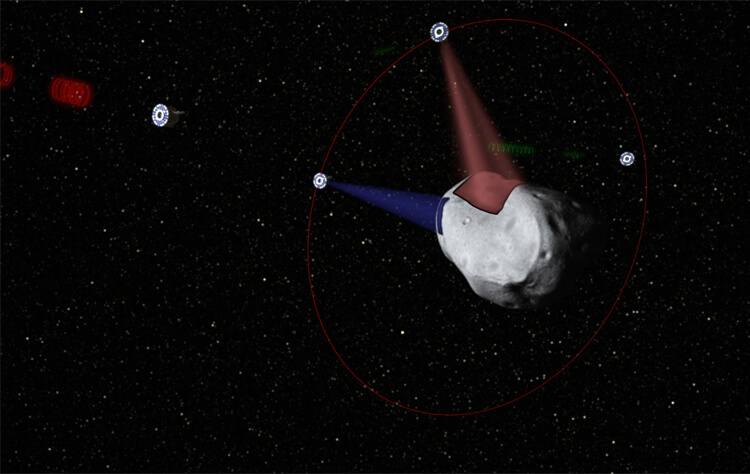
Most asteroids are processed in situ, as opposed to Earth orbit, due to fears of an accidental impact. For now, manoeuvring larger asteroids is seen as expensive and unnecessary in any case. Water-rich asteroids are particularly useful as the constituent hydrogen and oxygen can be turned into rocket fuel. As part of the commercialisation of space, numerous fuel depots are in place around the Earth-Moon system and Lagrange points. These are further reducing the cost of spaceflight, with most ships only required to carry enough fuel to get into orbit. Longer and more complex missions are possible with supplies available en route.*
Asteroid mining has proven to be one of the great confirmations of people's hopes for outer space. A single rock just a mile or so in diameter may yield more platinum group metals than has ever been mined on Earth, and more fuel than every rocket launch in history.* The resources now being added to the global economy are helping to meet demand in many areas. However, significant portions of raw materials are being diverted to off-planet projects including the construction of new space stations. As a result, various non-profit groups have sprung up, aiming to ensure that poorer nations can benefit from space, not just the countries and rich individuals that can afford to go. The lucrative nature of this business and its growing influence on Earth has led to the passing of major new regulations, antitrust and monopoly laws.*
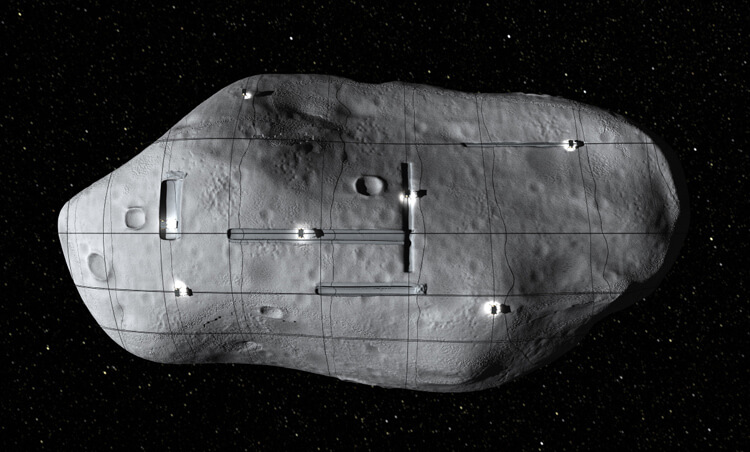
Ongoing conflicts around the world have spurred military powers to new heights. Developed nations are now turning to space to gain the advantage in next generation warfare.* The USA is prolific in this regard. In earlier decades, international treaties prevented the militarisation of space. However, some of the more powerful nations have moved projects forward in secret. In any case, the volatile and rapidly evolving political climate has led to new agreements being introduced.
A whole new dimension to war is emerging, in parallel with the commercialisation of space. The USA, for example, has established a comprehensive network of spy satellites, each equipped with a wide array of sensors able to observe people and objects on the ground with astounding resolution and detail. AI controls this system, automatically tracking known persons of interest and monitoring for suspicious activity. If enemy actions on the ground cannot be rationalised by the AI, government and military personnel are notified of it. Now controlling the most advanced and intelligent surveillance system in the world, America has regained some of its lost influence on the world stage.
Naturally, other countries object to what they see as a potential for abuse of power. Alongside the spy satellites are manned space stations, placed strategically in geosynchronous orbit. These act as command centres, able to view battles from above in real time while giving directions to forces on the ground. Notably, they allow the military to organise and deploy squadrons of autonomous aircraft and robots. They also ensure that there are repair crews constantly on call, in the event of spy satellites or other craft malfunctioning. In today's hi-tech, fast-moving wars, communication and information are of unparalleled importance. These stations act as intelligence centres of sorts, and as such become prized targets for enemy forces. Knowing this, no expense is spared when it comes to advanced shielding and warning systems.
The first space-based weapons systems are also in place. Most incorporate traditional missile capabilities, but other, more experimental systems are being utilised. One such weapon is an orbital kinetic bombardment platform operated by the US.* This consists of two satellites in parallel orbits. The first provides a target and communication function, taking instructions from the ground on potential enemies. The second satellite is armed with several 20-foot long, specially reinforced tungsten rods, each complete with tail fins and an internal guidance computer. Upon instruction, a rod is released over a ground target and begins to fall. Using nothing but gravity and pure force, these missiles can impact with the power of a tactical nuclear warhead – only without the deadly fallout. Almost no bunker is safe, as the weapon lands with utterly devastating force, penetrating deep underground. Several problems needed to be overcome before this system was operational, such as the cost of lifting the materials into space and creating rods of sufficient strength to withstand the energies involved. Years of experimentation have finally yielded a metal alloy tough enough to be used. This project – the ultimate in bunker busting technology – is highly secretive and only tested in the deserts of the American southwest.
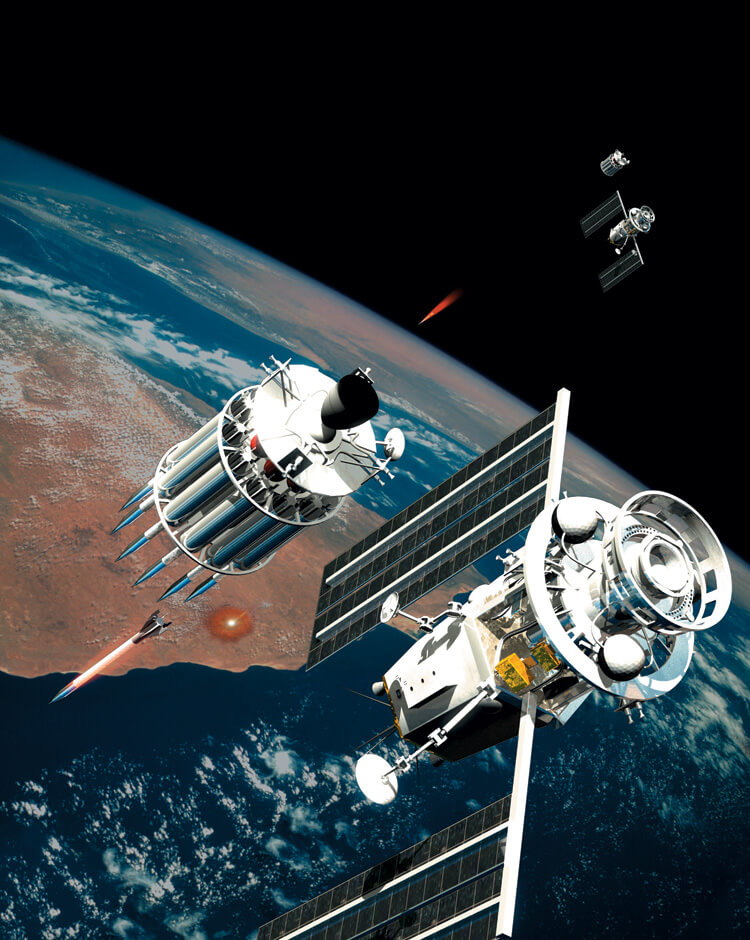
Orbital solar power, since its introduction nearly 15 years ago, has grown considerably.** Various new stations are now in place, able to provide continuous power to Earth. In addition to commercial power production, orbital solar has been found to have military applications. Modern armies no longer require a fixed source of power, with energy beamed down to even the most remote locations. Naturally, these solar power systems, as well as much of the other activity in space, increase the danger of space junk. However, genuine solutions are now finally appearing that can eliminate such debris once and for all. One option is the use of ground-based lasers, which move larger pieces into decaying orbits to eventually burn in the atmosphere,* while massive aerogel nets guided by satellites can sweep up the finer particles in orbit.*
AI and robotics have played a major role in opening up space.* Automated construction of spaceships and supplies is another area of reduced expense, while AI is used by asteroid mining companies to operate their wide range of robotic explorers and miners. In general, the increasingly complex and chaotic network of spacecraft now in place has necessitated the use of strong AI to coordinate operations. Many jobs previously filled by humans have now been given over exclusively to robots and computer programs. Spaceships are almost never piloted by human hands, with everything from docking to refueling to landing completely automated. Naturally, many passengers view this level of AI control with trepidation, cultural fears still being a part of space travel.* Farther away from Earth, numerous robotic probes, each equipped with their own AI, are exploring the planets, moons and asteroids of the outer Solar System. These are yielding unprecedented amounts of empirical data about the nature of these bodies and the early history of the Solar System.
Space-based telescopes have seen phenomenal improvements over the decades. Exponential progress has led to telescopic power increasing by a factor of over 100,000.* Thanks to this astounding rate of advancement, it is now possible to view extrasolar planets in close detail.
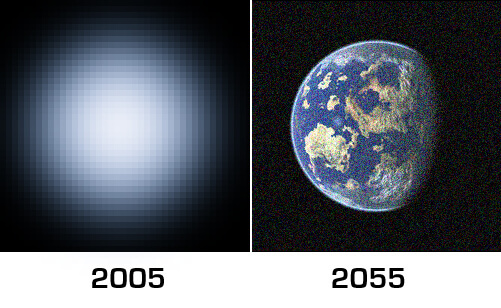
The number of known planets beyond our Solar System – about 800 in 2012 – has grown to 13 million by 2055.* Thousands of these bodies have been observed in the habitable "Goldilocks" zones of their respective star systems, including a number of Earth-like planets with liquid water oceans and active hydrological cycles. The possibility of finding alien life expands greatly during this time, as does the hope of achieving contact with intelligent civilisations. Despite the huge progress in this field, however, humans have still barely scratched the surface of the Milky Way.*
Recent progress has been achieved with antimatter propulsion – making human travel to the outer Solar System a real possibility in the coming years.* A permanent base on Mars is in the late planning stages, set to be established by a consortium of national governments and corporate interests. Longer-term projects are now being considered, with international talks being held over the future construction of a space elevator, to be located on the equator. Corporations are also looking to the massive, untapped wealth of the gas giants and outer Solar System as an eventual goal. By all accounts, private interests are driving a new era of space exploration.* Rapid progress in science and technology, combined with surging demand for resources, imply that humanity is well on its way to becoming a space-faring civilization.***
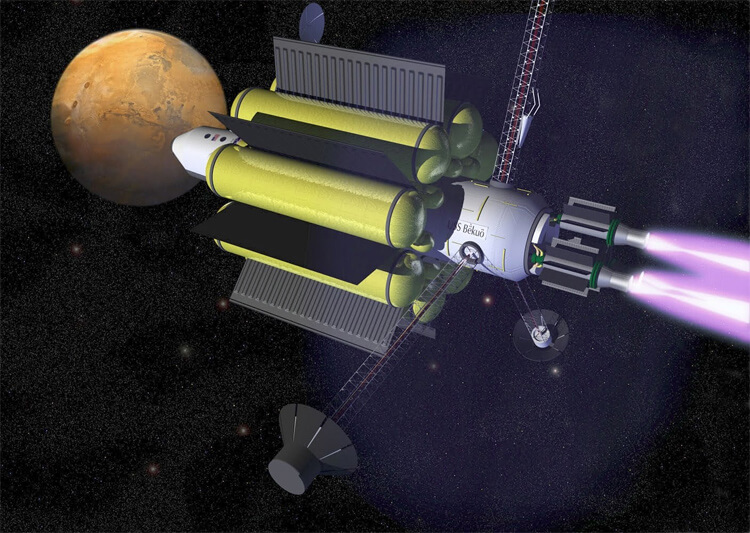
The vast majority of countries have achieved democracy
The on-going spread of information – aided by mobile telecommunications, social media and other technology – continues to nurture democracy. The vast majority of countries now have free and fair elections.*
However, this general upward trend has begun to plateau in recent decades. Climate change is now having a significant impact on regional stability, particularly in Africa and the Middle East, where concerns over scarcity of resources have created conditions allowing dictators and authoritarian governments to make a comeback.
In any case, a number of cultures are simply more compatible with monarchies, theocracies and autocracies at the present time. These parochial nations will remain undemocratic for some time to come.
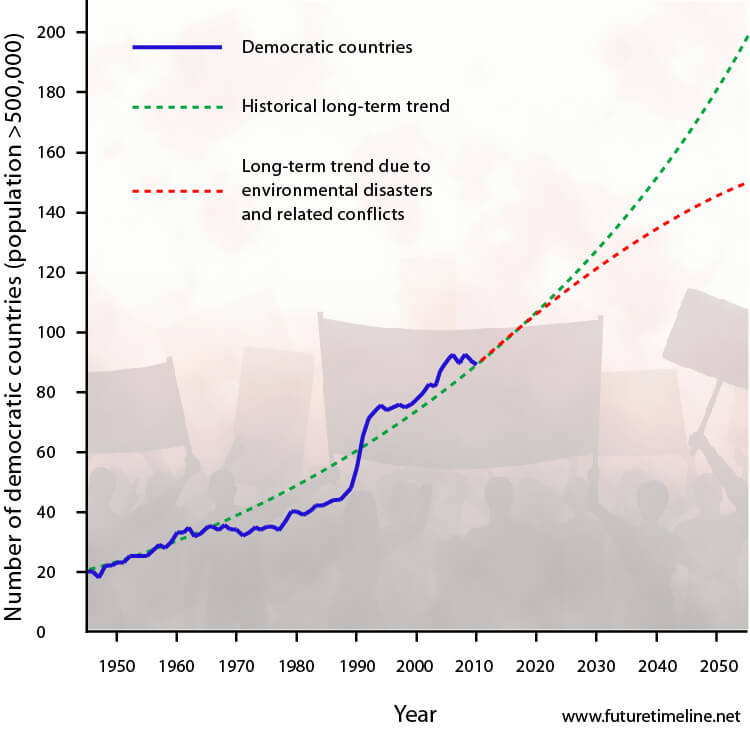
Global population is reaching a plateau
The global population is stabilising at between 9 and 10 billion.* Most of the recent growth has occurred in the developing world. However, better education along with improved access to contraception, family planning and other birth control methods is now markedly reducing the number of children per couple. Information technology has played a major role in boosting literacy levels and spreading knowledge to the world's poor.
The global population is also getting older, putting a huge strain on government welfare systems and employment. More than a fifth of the planet is aged over 60 now* – and with so many breakthroughs in medicine, this trend will only continue.
More than two-thirds of people live in urban areas by this time,* compared with 50% in 2010,* and there are vast, sprawling megacities in all corners of the globe. In the very densest parts of the world, the tallest skyscrapers reach thousands of metres in height, are occupied by millions of people, and are effectively cities in their own right with self-sufficient energy and food production. Many residents within these towers spend almost their whole lives in these buildings, with little need or want to venture outside.
The population of the USA has reached nearly 450 million now (up from 309 million in 2010), with Hispanics doubling their share of the population to 30% and Asians going from 5% to 9%. Non-Hispanic whites have become a minority, with their share dropping to below 45%.* They made up 85% of the population in 1960. Due to climate change, living standards have been highest in the northern states, which have better access to water and are generally more stable. California, Arizona, New Mexico and Texas have seen huge declines in wealth and influence.
Despite recent advances in energy, food production and other technology, there are still widespread conflicts around the globe – due to a rapidly worsening environment, coupled with a host of socio-political issues as the world struggles to adopt a more sustainable economic paradigm. Huge shantytowns have formed in some countries, with millions of people displaced. The worst-affected regions are so destitute that they have been reclassified as "fourth world" countries.* Desperate attempts are now underway to sequester carbon from the atmosphere in the hope of reversing the effects of global warming.

« 2054 |
⇡ Back to top ⇡ |
2056 » |
If you enjoy our content, please consider sharing it:
References
1 JSC Celebrates 40 Years of Human Space Flight, NASA:
http://www.jsc.nasa.gov/history/jsc40/jsc40_pg20.htm
Accessed 26th May 2012.
2 Russia Develops Revolutionary Ammonia Rocket Engine, space-travel.com:
http://www.space-travel.com/reports/Russia_Develops_Revolutionary_Ammonia_Rocket_Engine_999.html
Accessed 26th May 2012.
3 See 2021.
4 Lunar boom: Why we'll soon be mining the moon, PhysOrg:
http://phys.org/news/2012-05-lunar-boom-moon.html
Accessed 26th May 2012.
5 The Energy Paradigm Shift Opens the Door to a Sustainable Society, Shimizu Corporation:
http://www.shimz.co.jp/english/theme/dream/lunaring.html
Accessed 26th May 2012.
6 Planetary Resources unveils cosmic plan 'to boldly go' and mine asteroids for gold and platinum, The Telegraph:
http://www.telegraph.co.uk/finance/newsbysector/industry/mining/9222766/Planetary-Resources-unveils-cosmic-plan-to-boldly-go-and-mine-asteroids-for-gold-and-platinum.html
Accessed 26th May 2012.
7 2,000 Apply for Jobs Building Asteroid-Mining Robots, Space.com:
http://www.space.com/15686-asteroid-mining-jobs-planetary-resources.html
Accessed 26th May 2012.
8 Mining The Sky: Untold Riches From The Asteroids, Comets, And Planets, John S Lewis:
http://www.amazon.com/Mining-The-Sky-Asteroids-Planets/dp/0201328194
Accessed 26th May 2012.
9 Planetary Resources Inc.:
http://www.planetaryresources.com/
Accessed 26th May 2012.
10 The Space Economy: A Modern Day Gold Rush, Planetary Resources Inc. (press release):
http://www.multivu.com/assets/55879/photos/55879-SpaceEconomy-original.jpg?1335284263
Accessed 26th May 2012.
11 Asteroid Mining: Science or Fiction, David Brin:
http://www.youtube.com/watch?v=luQl8vFOEa8
Accessed 26th May 2012.
12 The Next 100 Years: A Forecast for the 21st Century, George Friedman:
http://www.amazon.com/The-Next-100-Years-Forecast/dp/038551705X
Accessed 26th May 2012.
13 Rods from God: Space-launched darts that strike like meteors, PopSci:
http://www.popsci.com/scitech/article/2004-06/rods-god
Accessed 26th May 2012.
14 See 2041.
15 Exclusive: Orbital solar power plants touted for energy needs, Reuters:
http://www.reuters.com/article/2011/11/13/us-space-energy-solar-idUSTRE7AC0J120111113
Accessed 26th May 2012.
16 NASA Studies Laser for Removing Space Junk, Technology Review:
http://www.technologyreview.com/blog/arxiv/26512/
Accessed 26th May 2012.
17 For Space Mess, Scientists Seek Celestial Broom, The New York Times:
http://www.nytimes.com/2012/02/19/science/space/for-space-mess-scientists-seek-celestial-broom.html?_r=1
Accessed 26th May 2012.
18 The Singularity Is Near: When Humans Transcend Biology, Ray Kurzweil:
http://www.amazon.com/The-Singularity-Is-Near-Transcend/dp/0143037889/
Accessed 26th May 2012.
19 2001: A Space Odyssey, IMDB:
http://www.imdb.com/title/tt0062622/
Accessed 26th May 2012.
20 "Telescopic power is rising quickly, possibly at 26% a year."
See SETI and the Singularity, The Futurist:
http://www.singularity2050.com/2009/05/seti-and-the-singularity.html
Accessed 26th May 2012.
21 Extrapolated from the following graph:
A Plethora of Planets: Number of Known Exoplanets Soaring, Scientific American:
http://blogs.scientificamerican.com/observations/2011/09/20/a-plethora-of-planets-number-of-known-exoplanets-soaring/
Accessed 26th May 2012.
22 Free-floating planets in the Milky Way outnumber stars by factors of thousands, Space Daily:
http://www.spacedaily.com/reports/Free_floating_planets_in_the_Milky_Way_outnumber_stars_by_factors_of_thousands_999.html
Accessed 26th May 2012.
23 Antimatter and Fusion Drives Could Power Future Spaceships, Space.com:
http://www.space.com/17537-antimatter-fusion-engines-future-spaceships.html
Accessed 16th September 2012.
24 Billionaires back ambitious space projects, USA Today:
http://www.usatoday.com/tech/science/space/story/2012-04-25/space-exploration-billionaires/54866272/1
Accessed 26th May 2012.
25 The Case for Space: Why We Should Keep Reaching for the Stars, Foreign Affairs:
http://www.foreignaffairs.com/articles/137277/neil-degrasse-tyson/the-case-for-space
Accessed 26th May 2012.
26 Your ticket to Mars will cost only half a million dollars, io9:
http://io9.com/5894987/your-ticket-to-mars-will-cost-only-half-a-million-dollars
Accessed 26th May 2012.
27 Space Chronicles: Facing the Ultimate Frontier, Neil deGrasse Tyson:
http://books.wwnorton.com/books/Space-Chronicles/
Accessed 26th May 2012.
28 Extrapolated from the following graph:
Global Trends in Governance, 1800-2016, The Center for Systemic
Peace (CSP):
http://www.systemicpeace.org/conflicttrends.html
Accessed 29th December 2017.
29 World Population Prospects, the 2010 revision, The United Nations:
http://esa.un.org/unpd/wpp/unpp/panel_population.htm
Accessed 11th March 2012.
30 Global ageing statistics, HelpAge International:
http://www.helpage.org/resources/ageing-data/global-ageing-statistics/
Accessed 11th March 2012.
31 19.20.21,
http://www.192021.org
Accessed 18th Jan 2009.
32 Urbanisation, BBC:
http://news.bbc.co.uk/1/shared/spl/hi/world/06/urbanisation/html/urbanisation.stm
Accessed 11th March 2012.
33 Minorities set to be US majority, BBC:
http://news.bbc.co.uk/1/hi/7559996.stm
Accessed 11th March 2012.
34 The Meaning of the 21st Century: A Vital Blueprint for Ensuring Our
Future, James Martin:
http://www.amazon.com/Meaning-21st-Century-Blueprint-Ensuring/dp/B001G8WI6E/
Accessed 1st May 2010.
![[+]](https://www.futuretimeline.net/images/buttons/expand-symbol.gif)






